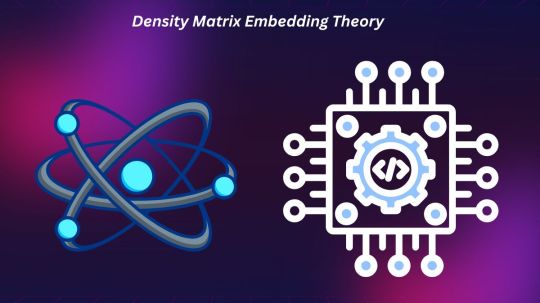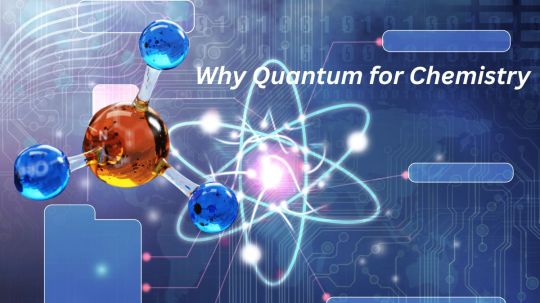#quantumcentricsupercomputing
Explore tagged Tumblr posts
Text
Density Matrix Embedding Theory & SQD for Quantum Modelling

Density Matrix Embed Theory
Combining Quantum Simulation Methods to Address Complex Molecules for Medical Progress
Michigan State University, IBM Quantum, and the Cleveland Clinic proved that hybrid quantum-classical techniques can accurately represent complex molecules using quantum computers, a major quantum chemistry breakthrough. Combining Density Matrix Embedding Theory (DMET) and Sample Based Quantum Diagonalisation (SQD), this groundbreaking finding advances quantum-centric scientific computing and has major health and medical implications.
Unlocked with Hybrid Quantum-Classical Power
Even the most advanced supercomputers have struggled to simulate huge molecule stability and behaviour, which is crucial for disease understanding and treatment. Modern high-performance computers cannot track over 33,000 molecular orbitals, which is needed to simulate insulin. Classical techniques fail as molecules increase larger. In addition, classical mean-field approximations fail to capture crucial electron interactions.
The first implementation of the SQD algorithm on genuine quantum hardware and incorporation into the Density Matrix Embedding Theory framework in this paper offers hope. This unique method, DMET-SQD, could replicate hydrogen rings and cyclohexane conformers. The DMET-SQD method replicates chemically important sections of a molecule instead than the entire molecule, which would need thousands of qubits. These fragments are then combined into an approximate electronic environment.
Quantum-centric supercomputing (QCSC) is defined by this “division of labour” between quantum and classical resources. The quantum processor in QCSC does the most computationally difficult operations, while regular high-performance computers handle the rest, including error correction. This hybrid technique allows state-of-the-art quantum computers without error-correcting capabilities to handle larger and more chemically realistic molecules. The Cleveland Clinic's IBM-managed quantum device, IBM Cleveland, the first of its type in the US, used 27 to 32 qubits in the study.
Real-World Accuracy Benchmarking
The researchers employed DMET-SQD to critically assess their hybrid technique on a ring of 18 hydrogen atoms and different cyclohexane conformers. Hydrogen rings are a standard benchmark in computational chemistry due to their high electron correlation effects, while cyclohexane conformers (chair, boat, half-chair, and twist-boat) are common in organic chemistry due to their narrow energy range, which makes them sensitive to even small computational
Heat-Bath Configuration Interaction (HCI), which may approach exact solutions, and Coupled Cluster Singles and Doubles with perturbative triples [CCSD(T)] were compared to quantum-classical results. The results were promising: DMET-SQD energy differences across cyclohexane conformers were within 1 kcal/mol of the best conventional reference methods, a standard chemical accuracy criterion.
For sufficiently large quantum configuration samples (8,000–10,000), DMET-SQD met HCI benchmarks for the hydrogen ring with negligible deviation while retaining cyclohexane conformer energy ordering. These results demonstrate that the technique may properly model physiologically relevant molecules despite hardware limitations.
Noisy Quantum Hardware Engineering Solutions
Practical usage of this embedding strategy on quantum technologies distinguishes the study. Modern quantum devices are noisy and unreliable. However, SQD's noise tolerance considerably reduced common errors. The authors stabilised calculations on IBM's Eagle processor via gate whirling and dynamical decoupling.
The team designed a custom interface to connect Tangelo's Density Matrix Embedding Theory library to Qiskit's SQD implementation. The simulation uses Hartree-Fock configurations encoded by each quantum circuit to maintain particle number and spin characteristics. These configurations were refined using S-CORE.
Future Outlook and Major Implications
Although the DMET-SQD technique is revolutionary, it has limitations and is still in its infancy. The fragment size and quantum sampling quality affect simulation accuracy. In systems with small energy changes or considerable electrical correlation, poor sampling may cause irregular energy ordering. The present study used a minimum basis set; chemically relevant applications will require more complex basis sets, qubits, and error control.
Study authors say more work is needed to improve sampling and reduce standard post-processing computer demand. Quantum hardware improvements in error rates and gate integrity will be crucial to scaling and enhancing these simulations.
This work suggests that hybrid quantum-classical approaches can handle real chemical processes better than “toy models.” Breaking full-molecule simulations into quantum computer-solvable subproblems allows scientists to solve previously intractable drug development and materials science problems.
Lead author Kenneth Merz, PhD, of the Cleveland Clinic, said, “This is a groundbreaking step in computational research that demonstrates how near-term quantum computers can advance biomedical research.” If they grow, DMET-SQD or similar hybrid techniques may anticipate novel materials, reaction mechanisms, and protein-drug interactions by accurately describing quantum effects in huge molecules. This breakthrough launches a new age of computational study that will directly help disease diagnosis and therapy.
#IBMQuantum#DensityMatrixEmbeddingTheory#quantumcentricsupercomputing#ibm#news#quantumhardware#hybridquantum#DMETSQD#technology#technews#govindhtech
0 notes
Text
IBM’s Hybrid Quantum-Classical Method to Open Shell Systems

Open-shell systems
IBM and Lockheed Martin Improve Chemistry Simulation with Classical and Quantum Computing
New research represents complex open-shell molecules used in materials science and aerospace using a hybrid method.
IBM Quantum and Lockheed Martin experts showed how quantum computers can accurately describe electrical systems in The Journal of Chemical Theory and Computation. Some molecules' structures are difficult to duplicate using classical methods. These challenging compounds are called “open-shell” molecules.
This study is the first to employ sample-based quantum diagonalisation (SQD) on open shell systems. IBM researchers believe SQD is a promising candidate for near-term quantum advantage demonstrations because it allows researchers to use high-performance quantum and conventional computers to solve tough simulation challenges.
Quantum Chemistry—Why?
Quantum chemistry has long been considered a promising use of quantum computers. High-performance computers struggle to model transition metals, radical species, transition states, and excited states due to strong electron correlation. The processing cost of precisely simulating even small molecules increases exponentially with the number of interacting electrons, making ideal solutions almost impossible.
Quantum computers offer an alternative. Quantum computer simulations of quantum chemistry can accurately calculate these complex systems' electronic structure and energy. As they acquire fault-tolerance, quantum computers may mimic strongly coupled systems more accurately and at bigger scales than classical approximation methods. In computational chemistry, a singlet-triplet gap is a crucial energy difference between molecule electronic states. These transition energies are essential for understanding chemical reactivity, generating compounds with specific properties, modelling excited-state behaviour in materials, and confirming studies.
Modelling open-shell molecules with unpaired electrons is tricky. Open shell systems are more sophisticated than closed-shell molecules with all electrons linked. High reactivity, magnetic properties, and sophisticated “multi-reference” electronic structures that need several wave functions for correct representation are achievable. These properties are important in atmospheric, catalytic, and combustion chemistry, but modelling is difficult.
Their unpaired electrons create a complicated correlation structure, making radicals and transition metal complexes difficult to manage using classical methods. Quantum algorithms are superior for open shell systems because they naturally encode and process electron entanglement.
Methylene (CH2): A Key Test Case
Most recent research focused on methylene (CH2). Atmospheric chemistry, combustion emissions, and interstellar activities depend on CH2, a three-atom reactive molecule.
Electronically, CH2 has a diradical triplet ground state. This state gives the carbon atom a spin of one due to its outer shell of two unpaired electrons with parallel spins. CH2's stable, low-energy triplet form is interesting. The initial excited state is a carbene singlet state with opposing spins on the carbon electrons.
The singlet-triplet energy gap, the energy difference between these states, must be accurately predicted to understand CH2's behaviour in complex chemical processes. Classical methods often struggle to estimate this gap in open-shell compounds like CH2.
Quantum computers can simulate CH2 and other radical species' reactivity because they can manage complex wavefunctions and electron correlations.
Study Results
Using an IBM quantum processor and SQD, the researchers determined CH2's singlet and triplet dissociation energies and energy gaps. This study legitimises quantum approaches for molecules with complex electronic structures, such as carbenes and radicals, by applying the SQD method to an open-shell system for the first time.
Compared to high-accuracy classical techniques (Selected Configuration Interaction, or SCI), studies showed:
Singlet dissociation energy is strongly agreed upon within a few milli Hartrees of the SCI reference.
Near equilibrium geometries have consistent triplet energies. accurate singlet-triplet energy gap prediction that matches experiment and classical modelling.
The computations used a 52-qubit IBM quantum processor and up to 3,000 two-qubit gates per experiment.
Quantum-focused supercomputing
IBM's quantum-centric supercomputing infrastructure, which blends quantum computers with regular computing resources, hosted the experiment. This method allows scalable molecular system simulations.
This study reveals that quantum computers are beginning to succeed in chemical simulations. Radical molecules are crucial in sensor design, combustion chemistry, and aerospace, and simulating their behaviour can improve predictive models and new technologies. As quantum hardware and SQD improve, this strategy allows quantum tools to model complex reaction dynamics and develop superior materials.
#Openshellsystems#quantumchemistry#samplebasedquantumdiagonalisation#openshellmolecules#quantumcentricsupercomputing#SQD#technology#technews#technologynews#news#govindhtech
0 notes